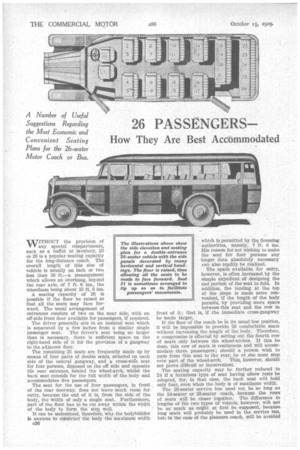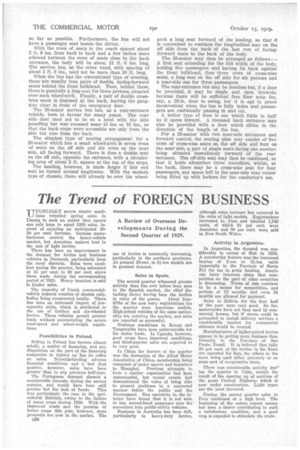26 PASSENGERS
Page 74

Page 76

If you've noticed an error in this article please click here to report it so we can fix it.
How They Are Best Accommodated
A Number of Useful Suggestions Regarding the Most Economic and Convenient Seating Plans for the 26-seater Motor Coach or Bus.
WITFIOUT the provision of any special compartments, such as a buffet or lavatory, 25 or 26 is a popular seating capacity for the long-distance coach. The overall length of this size of vehicle is usually an inch or two less than 26 ft.—a measurement which allows an overhang, beyond the rear axle, of 7 ft. 6 ins., the wheelbase being about 15 ft„ 6 ins.
A. seating capacity of 26 is possible if the floor be raised so that all the seats may face for ward. The usual arrangement of entrances consists of two on the near side, with an off-side front door available for passengers, if required.
The driver generally sits in an isolated seat which is separated by a few inches from a similar single passenger seat. The driver's seat being no larger than is necessary, there is sufficient space on the right-hand side of it for the provision of a gangway to the adjacent door.
The remaining 25 seats are frequently made up by means of four pairs of double seats, situated on each side of the central gangway, and a cross-wige seat for four persons, disposed on the off side and opposite tile rear entrance, behind the wheel-arch, whilst the back seat extends for the full width of the body and • accommodates five passengers.
The seat for the use of four passengers, in front of the rear doorway, does not leave much room for entry, because the end of it is, from the side of the body,, the width of only a single seat. Furthermore, • part of the floor has to be cut away within the width of the body to form the step Well.
It can be understood, therefore, why the bodybuilder Is anxious to construct the body the maximum width c36
which is permitted by the licensing authorities, namely, 7 ft. 6 ins. His reason for not wishing to make the seat for four persons any longer than absolutely necessary can also readily be realized.
The space available for entry, however, is often increased by the simple expedient of designing the end portion of the seat to fold. In addition, the landing at the top of the steps is made more convenient, if the length of the body permits, by providing more space between this seat and the row in is, if the immediate cross-gangway
If the floor of the coach be in its usual low position, it will be impossible to provide 26 comfortable seats without increasing the length of the body. Therefore, a compromise is effected by setting out the fourth row of seats only between the wheel-arches. If this be done, this row of seats is continuous and will accommodate three passengers; should a person wish to pass from this seat to the rear, he or she must step over part of the wheel-arch. This, however, should not prove difficult or inconvenient.
The seating capacity may be further reduced to 24 if a luxurious type of seat having elbow rests be adopted, for, in that case, the back seat will hold only four, even when the body is of maximum width. The 26-seater service bus need not be so long as the 24-seater or 26-seater coach, because the rows of seats will be closer together. The difference in lengths of the two types of vehicle, however, will not be as much as might at first be supposed, because long seats will probably be used in the service bus, but, in the case of the pleasure coach, will be avoided
so far as possible. Furthermore, the bus will not have a passenger seat beside the driver.
With the rows of seats in the coach spaced about 2 ft. 9 ins, from back to back and a few inches more allowed between the rows of seats close to the back Entrance, the body will be about 21 ft. 6 ins. long. The service bus, on the other hand, with spacing of about 2 ft. 3 ins., need not be more than 20 ft. long.
When the bus has the conventional type of steering, there are usually four pairs of double, facing-forward seats behind the front bulkhead. Then, behind these, there is generally a long seat for three persons, situated over each wheel-arch. Finally, a pair of double cross-. wise seats is disposed at the back, leaving the gangway clear, in front of the emergency door.
The 26-seater service bus has, as a rear-entrance vehicle, been in favour for many years. The rear side door used not to be on a level with the side panelling but was' recessedsome 15 ins. or 16 ins., so that the back steps were accessible not only from the side but also from the back.
The simplest type of seating arrangement for a 26-seater which has a small wheel-arch is seven rows of seats on the off side and six rows on the near side, all facing forward. There is then a double seat on the off side, opposite the entrance, with a circulating area of about 3 ft. square at the top of the steps.
The landing, however, is made larger if this end seat be turned around lengthwise. With the modern type of chassis, there will already be over the wheel arch a long seat forward of the landing, so that it is convenient to continue the longitudinal seat on the off side from the back of the last row of facingforward seats to the back of the body.
The 26-seater may then be arranged as follows :— A first seat extending for the full width of the body, holding five passengers and having its back against the front bulkhead, then three rows of cross-wise seats, a long seat on the off side for six persons and a near-side one for three passengers.
The rear-entrance bus may be doorless but, if a door be provided, it may be single and open inwards, because there will be sufficient free floor area for, say, a 28-in, door to swing, but it is apt to prove inconvenient when the bus is fully laden and passengers are continually passing in and out.
A better type of door is one which folds in half as it opens inward. A recessed back entrance may also be provided with a door which slides in the direction of the length of the bus.
For a 26-seater with two near-side entrances and forward control, the seating plan may consist of five rows of cross-wise seats on the off side and four on the near side, &pair of single seats facing one another being situated immediately forward of the rear entrance. The off-side seat may then be continued, so that it holds altogether three travellers, whilst, at the back, there may be a cross-wise seat for four passengers, any space left in the near-side rear corner being fitted up with lockers for the conductor's use.




























































































































